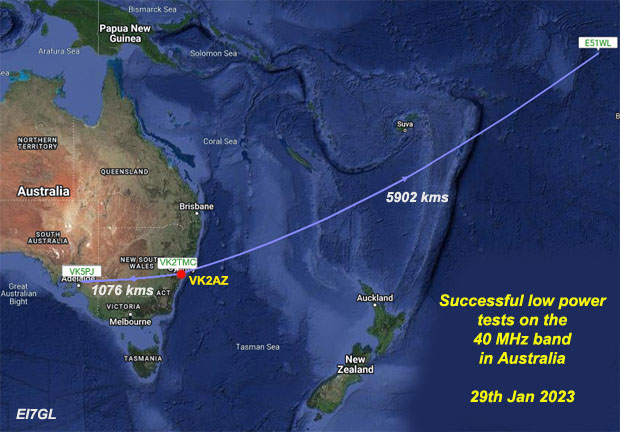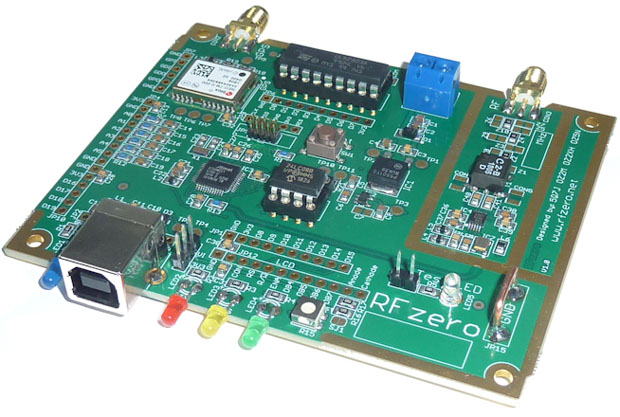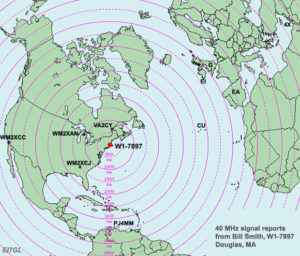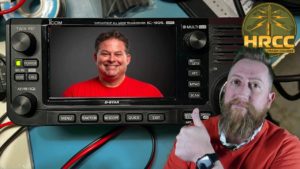Successful low power tests on the 40 MHz band in Australia – 29th Jan 2023

In Australia and New Zealand, anyone can use up to 1-watt ERP on a non-interference basis without a license on the 40 MHz ISM band. Hilary, VK2AZ has taken advantage of this and has been experimenting with a WSPR beacon on 40.680 MHz since the end of December 2022.
On the 29th of January 2023, several stations heard the WSPR beacon from X/VK2AZ on 40.680 MHz. What’s really amazing is that the power output was just 0.005 watts or 5 milliwatts!
My beacon is an RFZero loaded with the WSPR transmitter code and an LPF (low pass filter) for 40MHz on its output. Currently, it puts out about 5 milliwatts WSPR every 10 mins on 40.680 MHz using the call X/VK2AZ.
The RFZero is also GPS locked. https://rfzero.net/examples/wspr-transmitter/
To my surprise, my 5-milliwatt beacon has been spotted at a considerable distance. On 29 Jan 2023, my beacon was spotted by Peter, VK5PJ in South Australia at a distance of 1076 km and Warwick, E51WL in the North Cook Islands at a distance of 5902 km.
Just goes to show that you don’t need a lot of power on these “Magic Bands”. In an email to Bob, ZL1RS, Warwick, E51WL described it as “nice wspr frames from that VK with his flea“
***
For his 40 MHz propagation tests, VK2AZ is using a horizontal dipole for 40 MHz and its broadside to Central America.
WSPR Spots from E51WL in the Cook Islands (5902 km) and VK5PJ near Adelaide…
 |
| RF Zero board |
VK2AZ has been monitoring 40MHz for about a year and a half now, hoping to see some activity from around the world using an ICOM IC-7100 and a horizontal dipole for 40MHz.
As reported in this previous post, VK2AZ managed to receive the WSPR signals from WM2XCC in California on the 28th of December 2022.
Analysis… First of all… WOW! What amazing reception reports for just 5 milliwatts and at 40 MHz as well! But what about the propagation mode?
VK5PJ at 1076 km was probably via Sporadic-E and the strongest report was -15dB which is buried in the noise. As it’s the Summer Sporadic-E season in the Southern Hemisphere then that’s easy to explain.
As for E51WL at 5902 km??? If it was Sporadic-E then we have to believe that it was something like 3 x 2000km hops. I suspect F2 propagation was involved and it was something like 2 x 3000km hops.
Whichever one you want to believe, it’s still amazing for just 0.005 watts.
The way forward… I have no doubt that we need more people using the WSPR beacon mode on 40.680 MHz. A lot of countries seem to allow people to transmit very low power on the 40 MHz ISM band without any particular sort of license or permit.
Wouldn’t it be great to have a load of low-power WSPR stations all over Europe for the Sporadic-E season? Check your local regulations.
Links… As always, there is loads of 8m information on my 40 MHz page.
If you have found a spelling error, please, notify us by selecting that text and pressing Ctrl+Enter.







